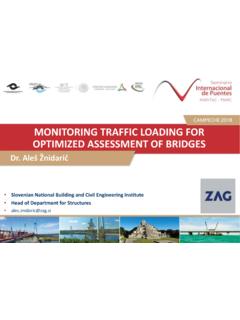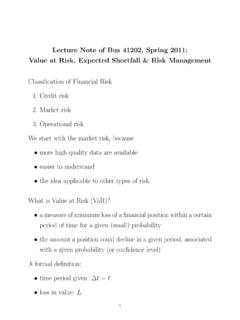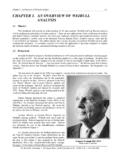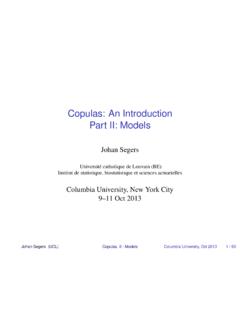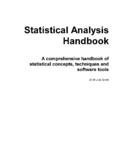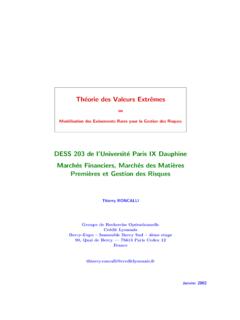Transcription of RESEARCH REPORT 016 - Health and Safety Executive
1 HSE Health & Safety Executive Guidelines for use of statistics for analysis of sample inspection of corrosion Prepared by TWI Limited for the Health and Safety Executive 2002 RESEARCH REPORT 016 HSE Health & Safety Executive Guidelines for use of statistics for analysis of sample inspection of corrosion TWI Limited Granta Park Great Abington Cambridge CB1 6AL United Kingdom This document is intended to advise plant engineers and inspection personnel on methods for analysing and extrapolating inspections for large plant items including vessels, pipework and pipelines, taking into account the statistical nature of corrosion. The document is intended to introduce the methods of statistical analysis of corrosion inspection data.
2 Before the methodology is included in standards, practical experience of industrial applications is needed to identify the most relevant distributions and statistical techniques. This REPORT and the work it describes were funded by the Health and Safety Executive (HSE). Its contents, including any opinions and/or conclusions expressed, are those of the author alone and do not necessarily reflect HSE policy. HSE BOOKS Crown copyright 2002 Applications for reproduction should be made in writing to: Copyright Unit, Her Majesty s Stationery Office, St Clements House, 2-16 Colegate, Norwich NR3 1BQ First published 2002 ISBN 0 7176 2554 0 All rights reserved. No part of this publication may be reproduced, stored in a retrieval system, or transmitted in any form or by any means (electronic, mechanical, photocopying, recording or otherwise) without the prior written permission of the copyright owner.
3 Ii SUMMARY Leakages of hydrocarbons provide both a serious risk of fire and explosion, and a loss of plant availability. Corrosion has been shown to cause in the region of 15% of the leakage occurrences. Inspection is carried out, particularly for internal corrosion by means of non-destructive test methods which give values of the pipe or vessel wall thickness. Typically these methods only sample the overall area of a plant. There are risks associated with this. The sampling may lead to inaccurate estimates of corrosion rate, especially where pitting has occurred, or may not address the fact that a sample needs to be extrapolated over the whole area of plant in order to give a realistic estimate of the minimum wall thickness in that area.
4 Statistical methods to improve the estimation of corrosion rate or to estimate the minimum thickness over a larger area have been suggested for over 50 years, and have been applied in a few isolated cases. These methods, when combined with reliability methods, offer a potential for obtaining better information from inspections by further analysis of the data collected and can produce predictions of future probability of leakage. However widespread application is not common, largely because the use of statistics requires specialist knowledge, and no reference standards exist. These guidelines are intended to provide an introduction to the techniques and capabilities of the statistical methods with view to their wider application in industry.
5 Iii iv TABLE OF CONTENTS 1 SCOPE OF 1 2 ACKNOWLEDGEMENT .. 1 3 BACKGROUND .. 2 4 INTRODUCTION STATISTICS AND CORROSION .. 3 FREQUENCY DISTRIBUTIONS .. 3 DETERMINATION OF DISTRIBUTION (UNKNOWN CORROSION).. 11 5 THE USE OF INSPECTION DATA .. 14 GENERAL COMMENTS ON DATA 14 DETERMINATION OF CORROSION RATE - CURRENT 14 SUGGESTED ANALYSIS METHODS NORMAL DISTRIBUTION .. 16 EXTREME VALUE FITTED DATA (TYPE 1 DISTRIBUTION).. 18 DETERMINATION OF CORROSION RATE .. 20 NUMBER OF SAMPLES NEEDED (EACH CASE) .. 21 CHOICE OF LOCATION .. 21 6 CASE STUDY: FAILED OIL PIPE .. 23 7 CONCLUSIONS .. 25 8 RECOMMENDATIONS .. 26 9 REFERENCES.
6 27 10 APPENDIX A CALCULATION OF CORRELATION DISTANCE .. 28 APPLICATION .. 28 HANNING 28 11 APPENDIX B CALCULATION OF INHERENT AND SAMPLING ERRORS .. 29 APPLICATION .. 29 v vi 1 SCOPE OF DOCUMENT This document is intended to advise plant engineers and inspection personnel on methods for analysing and extrapolating inspections for large plant items including vessels, pipework and pipelines, taking into account the statistical nature of corrosion. The document is intended to introduce the methods of statistical analysis of corrosion inspection data. Before the methodology is included in standards, practical experience of industrial applications is needed to identify the most relevant distributions and statistical techniques.
7 The analyses contained refer to areas where corrosion conditions are known to be alike. In general, to achieve these conditions the following must be similar: Materials Corrosion product/chemistry Temperature Flow rate Presence of inhibitor Fluid composition Presence of contaminants It should be noted that small changes in these parameters can cause wide changes in corrosion rate. Where conditions do change in the area to be inspected ( welds), this can be handled by collecting data from these specific locations and treating them separately for analysis. 100% inspection of a large area of plant is not a practical proposition in most cases; the majority of applications use sample inspection.
8 The majority also use ultrasonic thickness measurement for data collection, and this method is assumed for the most of this document. It is recognised that new methods for measurement of corrosion are becoming available, and a short review of the possible applications of these is included. The document also does not address: 1. the choice of locations for inspection made on a risk-based or experience-based methodology, targeted at hot spots , or 2. analysis of corrosion localised to specific locations in a plant It should be noted that the use of extreme values is particularly suitable for the evaluation of the potential for leakage, rather than bursting. For further guidance on the latter refer to the RACH (Reliability Assessment for Containers of Hazardous materials) project REPORT (1).
9 If the data does not fit the distributions described here then analysis by more advanced techniques may be necessary (for example Type 3 Extreme Value Distributions). Additional issues to be considered include the correlation between adjacent data points (Appendix A) and the estimation of inherent and sampling errors (Appendix B). TWI has drawn up these guidelines, at HSE s request, specifically in order to improve the sampling ultrasonic inspection of pipe, by making data collection, analysis and extrapolation available to non-specialists. However it should be pointed out that the guidance given here is introductory and more application experience is needed before standards can be developed.
10 2 ACKNOWLEDGEMENT The Health and Safety Executive , together with TWI, acknowledge the input from Mitsui Babcock Technology Centre in preparation of this document. 1 3 BACKGROUND Corrosion has been shown to be the cause of 15-20% of leakages of hydrocarbons from offshore plant (2). Leakages can lead to more disastrous consequences if subsequent ignition was to result in fire or explosion. In order to reduce the number of leakages from this source, the defects that lead to failure need to be detected and mitigating action taken before failure occurs. Corrosion is in essence a statistical effect (3) governed by a number of variables. For example, microscopic variations in a surface tend to cause different forms of corrosion and also variations in the corrosion rate over either a wide or small area (pitting).










